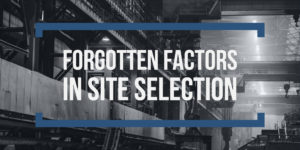 Corporate site selection is an infrequent occurrence for most companies. As a result, the employee or ad-hoc team assigned to design, direct and execute the site selection process often does not have the depth of experience or expertise to ensure an optimal outcome. Without the benefit of a site selection professional, the risks to the project increase greatly.
Corporate site selection is an infrequent occurrence for most companies. As a result, the employee or ad-hoc team assigned to design, direct and execute the site selection process often does not have the depth of experience or expertise to ensure an optimal outcome. Without the benefit of a site selection professional, the risks to the project increase greatly.
Site selection projects emerge from a variety of corporate circumstances and events. New market entry needs, increasing costs at current locations, regulatory changes, mergers and acquisitions, are just a few reasons why a company might seek a change in location.
There are just as many factors involved in how a new site is selected. Available real estate, taxes, economic incentives, the regulatory environment and utilities are all major considerations. However, in our decades of experience, we have repeatedly observed several important factors and practices that are too often omitted from the selection process. Here are a few common oversights that can jeopardize your site search.
Reviewing Current Property Assets
Companies with large portfolios of locations sometimes fail to sufficiently evaluate their own buildings and land-holdings for expansion viability. The enterprise-wide footprint needs to be thoroughly assessed on a regular basis to ensure cost-effective deployment strategies, which may not require costly new greenfield sites.
Engaging Stakeholders Early
Failing to effectively engage stakeholders early in the process and gather meaningful input and direction from all functional areas of a company is also common. Corporate location projects are often managed by one, key decision-maker based in the finance, human resources or corporate real estate group.
Mistakenly, other business function leaders are often brought into the site selection process only as needed or at the end for sign-off. This management style presents the risk of identifying key location decision criteria too late in the project process or not at all. It also diminishes the opportunity for the project to be an effective locus for change management and business process transformation.
Assessing Workforce Needs
Another key site selection vulnerability arises around workforce requirements for a new facility. There are several issues that are persistent stumbling blocks when it comes to workforce:
- Poorly estimating future headcount needs.
- Not clearly specifying the percentage of new hires that must have direct industry and functional experience.
- Miscalculating the duration of the recruiting, onboarding and training period for the planned facility based on existing and emerging labor market conditions.
- Ascertaining management’s willingness to accept adjustments to HR policies and practices based on local labor market dynamics.
These oversights can have a profound impact on decision-making and result in selecting sites in labor markets that cannot support workforce requirements.
Going for the Deal
Another frequent misstep is making a final location decision based on the attractiveness of a real estate deal. The right site and/or building is, of course, necessary, along with the availability of appropriate utilities and infrastructure. However, other factors may exert greater influence over future business success than the negotiating opportunity for a one-time property purchase. The ability to recruit and retain an appropriately skilled workforce within a sustainable cost structure trumps other considerations, especially in today’s labor-constrained environment.
Choosing the Hot Spot
Another potentially costly misdirection is the impulse to target popular locations. Demand for talent will be more intensive in popular areas, which can mean paying premium salaries to compete for qualified labor. Turnover and replacement costs also pose risks.
Other business costs, such as occupancy, tend to be pricey, too. While there might be a compelling reason to site a new facility in a trendy location, if there is not a powerful business case as to why then choosing a more practical location may pay greater dividends in the future.
These common pitfalls apply to site selection endeavors throughout the globe. Hopefully, our insights will be of value when your next site selection project comes along.
Are you looking for a professional site location consultant to help you with your next search? Visit our members page to find the right consultant for your next corporate location project.
